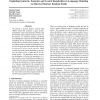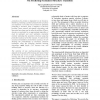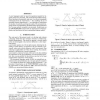1826 search results - page 13 / 366 » Using Random Forests in the Structured Language Model |
EMNLP
2010
13 years 6 months ago
2010
Graph-based methods have gained attention in many areas of Natural Language Processing (NLP) including Word Sense Disambiguation (WSD), text summarization, keyword extraction and ...
ICML
2005
IEEE
14 years 9 months ago
2005
IEEE
We present a directed Markov random field (MRF) model that combines n-gram models, probabilistic context free grammars (PCFGs) and probabilistic latent semantic analysis (PLSA) fo...
IJBRA
2007
13 years 8 months ago
2007
A function of a protein is dependent on its structure; therefore, predicting a protein structure from an amino acid sequence is an active area of research. Optimally predicting a ...
CORR
2000
Springer
13 years 8 months ago
2000
Springer
A new language model for speech recognition inspired by linguistic analysis is presented. The model develops hidden hierarchical structure incrementally and uses it to extract mea...
ACL
1994
13 years 10 months ago
1994
This paper shows how to formally characterize language learning in a finite parameter space as a Markov structure, hnportant new language learning results follow directly: explici...



